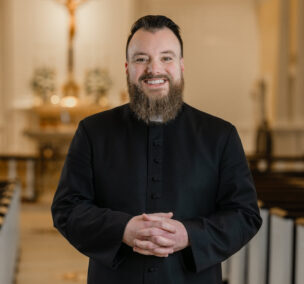Dear Brothers and Sisters in Christ,
Predicting the length of time remaining on the winter season by use of a burrowing mammal may seem like a quaint, if superstitious relic of a bygone era, commemorated only by an eccentric group of Pennsylvania men in top hats and a classic Bill Murray movie. Groundhog Day, though, has some surprising Catholic origins springing from a deliberate connection between the liturgical calendar, the changing of seasons, and observance of nature’s rhythms.
February 2 stands on the liturgical calendar as the Feast of the Presentation of the Lord (formerly the Purification of the Blessed Virgin Mary). The enduring name given to this feast is Candlemas. Forty days ago, we celebrated Christmas, the day of the birth of Christ. In keeping with the Jewish law, Mary and Joseph went to the Temple in Jerusalem forty days after Jesus’ birth to observe the ritual rites of purification and to make the customary offering (or presentation) for their son. Forty is a number that signifies fullness in Scripture. Thus, at the fullness or completion of these days, the Church traditionally marked the end of the Christmas season. With that end, we also note a shift in the Gospel stories from our Lord’s birth to His public ministry. Thus, we move into a different time, that of Jesus’ public ministry. But why “Candlemas?”
The great solemnity of the Nativity falls on the winter solstice, with the days following growing gradually longer. February 2 marks the halfway point between the winter solstice and spring equinox. If we take the Scriptural shift from the infancy narratives to the public ministry of Christ and the increasing hours of sunlight together, we can see the light of Christ symbolically reflected in the longer days ahead. With this focus on light, the custom of blessing the candles to be used in church on this day began to grow. On this day then the Church not only commemorates an important moment in the life of our Lord that encourages us to both allow the light of Christ into our hearts and to bring that light to the world, she also takes care of a practical matter by blessing the candles we use in worship. That’s all well and good, but what has it got to do with groundhogs?
A solstice or equinox is not the only way people have considered weather and seasons, historically. Noticing that about this time every year, certain burrowing animals were emerging from their hibernation, Christians in Europe connected the liturgical calendar (Candlemas) to nature (animals out of their dens) and weather predictions. In Germany, for example, they had a saying that ran “If the badger sunbathes during Candlemas week, for four more weeks he will be back in his hole.” Other countries substituted bears or hedgehogs for badgers, but with the same basic idea about the remaining weeks of winter. In the British Isles, a popular rhyme removed reference to animals but retained Candlemas, saying “if Candlemas Day be fair and bright winter will have another fight. If Candlemas Day brings cloud and rain, winter won’t come again.” German immigrants to the United States and the Pennsylvania Dutch transferred the animal reference to the groundhog, made it six weeks more or less of winter, and dropped Candlemas from their prediction about the coming of spring.
This connection of seasons, creation, and liturgy brings us back to the events commemorated on Candlemas. Mary and Joseph follow the dictates of the law, that law which is given by God to help his people rightly order their lives. Just as nature follows a particular order, we are reminded of our place in nature with the blessing of candles – called, in the words of the Easter Exultet, “the work of mother bees” – and of our need to be obedient to divine law. With our lives rightly ordered, we will more perfectly experience the light of Christ and be equipped to bring His light and life to the world.
Peace,
Fr. Sam


